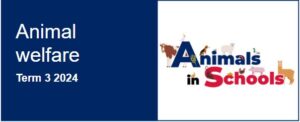Animal Care in Schools
The use of animals in schools for educational purposes is governed by the Animal Research Act (1985) NSW. Catholic Schools NSW meets a requirement of this Act by issuing an Animal Research Authority to each school annually. Learn more in the 2024 memorandum below.
MEMORANDUM: ANIMAL RESEARCH AUTHORITY FOR SCHOOL (April 2024)
Download CSNSW Memo Animal Research Authority
ANIMALS RESEARCH 2024 AUTHORITY (SCHOOLS)
Download form HERE
Please note: completed form needs to be stored on school site.
ANIMALS IN SCHOOLS WEBSITE
The Animals in Schools website has been designed to assist schools satisfy the requirements of the Animal Research Act 1985 (NSW) and the Australian code for the care and use of animals for scientific purposes.
In order to comply with the Animal Research Act 1985 (NSW) and to monitor the use of animals for teaching and research purposes in their schools, the school sectors have established the Schools Animal Care and Ethics Committee (SACEC).
The advice on the website is supported by the SACEC and is an outcome of the collaboration of the three NSW school sectors.
The site includes an explanation of the legislation governing the use of animals in schools, SACEC approved activities and their respective categories. It also provides detailed information about animals commonly used in schools, their handling and approved use.
Animals in Schools – application forms
Many activities using animals have blanket approval under the Animal Research Authority. For activities not blanket approved, approval from the Schools Animal Care and Ethics Committee (SACEC) must be sought.
Approval for particular activities
Animal welfare guidelines for teachers, sets out the responsibilities and requirements of NSW schools and teachers that use animals for educational purposes. Teachers are required to obtain written approval from the SACEC prior to commencement of any activities using animals for which approval is required.
A full list of approved activities and their corresponding categories can be viewed on the DoE website HERE.
Approval from the SACEC is required when teachers want to:
- allow students to carry out any category 4 or 5 activity (Application form 1)
- demonstrate a category 5 activity (Application form 4)
- allow students to carry out any activity, using animals, that are not included in the list of approved activities (Application form 1)
- demonstrate any activity, using animals, that are not included in the list of approved activities (Application form 4)
- apply for a scientific licence for keeping a native animal species that is not one of the five species covered by the school sector scientific licence.
ACCESS APPLICATION FORMS: HERE
BIOSECURITY IN SCHOOLS
Schools are busy places that have many students and staff entering and leaving the site daily, along with families and visitors . This increases the risk of plant and animal pests and diseases being spread. Schools have a responsibility to manage this risk.
Visit the NSW Government Education website for information on what schools must do.
LATEST NEWSLETTER

In this edition:
- Teaching resources
- Biosecurity
- Chemical storage use
Teaching Resources
A variety of resources are available for Animals in Schools, including the following videos, which can be found under Additional information for Teachers – animal management videos.
In the Animal welfare – student activities and worksheets, there are various resources available that can be used directly or adapted to meet your students’ needs. These include stimulus materials integrated with the activities.
Additional resources are available at Agriculture, including:
- Raising the steaks – the science of cattle breeding
- Plants in agriculture
Biosecurity
It is important to review biosecurity measures within schools, as these areas are considered high-risk due to the heavy foot traffic on farms. While the farm is a hub of engagement and activity, our goal is to minimise the risk of pest or disease transmission.
It is crucial to have an up-to-date biosecurity plan for your school farm. To assist with this, a range of templates is available at Biosecurity, which can be adapted to meet the specific needs of your school. Regularly reviewing your biosecurity plan and considering ways to reduce risks is essential.
Key strategies for managing biosecurity risks include:
- logging all livestock movements on the National Livestock Identification System database
- keeping animal care records up to date
- purchasing animal feed only from reputable suppliers
- ensuring that restricted animal materials are never fed to ruminant animals
- storing animal feed in vermin-proof bins
- controlling access by wild birds and pest species wherever possible
- managing through traffic on the farm
- knowing and sharing hotline contact numbers with other staff members
1800 675 888 (monitored 24 hours a day, 7 days a week)
1300 795 299 (business hours)
These measures will help to safeguard the health and safety of your school farm.As the Department of Primary Industries is responsible for managing the current outbreak of Avian Influenza, all advice is being provided by them. For the latest information, please visit Avain influenza.
Chemical storage use
It is essential that schools provide correct storage for all chemicals including drenches, vaccines and any medications prescribed by a veterinarian. This may include refrigeration for some chemicals.
All drugs and chemicals should be regularly checked for expiry dates and disposed of appropriately when they are out of date. When injections are used, needles must be disposed of using an appropriate sharps disposal container. Sharps containers can often be left at the local chemist for disposal.
All use of treatments must be documented in your animal care records. You must identify the animal treated and record the name of the chemical or treatment, dose administered, date administered, expiry date, batch number and withholding period of the treatment or chemical.
Subscribe to the newsletter: [email protected]

If you require further information about the Animal Research Authority or the Animal Research Establishment, please CSNSW
Wonder is the desire for knowledge - St Thomas Aquinas

